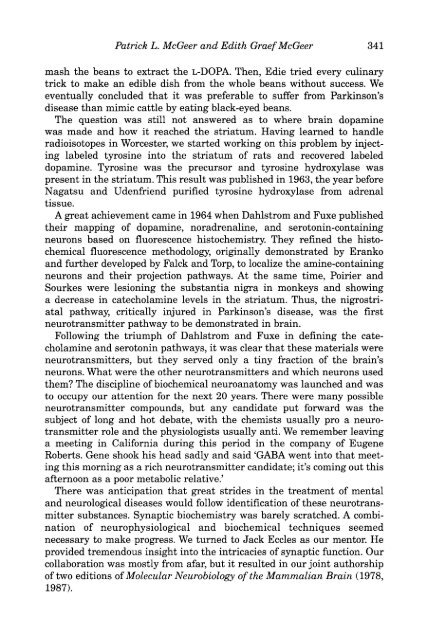Edith Graef McGeer - Society for Neuroscience
Edith Graef McGeer - Society for Neuroscience
Edith Graef McGeer - Society for Neuroscience
Create successful ePaper yourself
Turn your PDF publications into a flip-book with our unique Google optimized e-Paper software.
Patrick L. <strong>McGeer</strong> and <strong>Edith</strong> <strong>Graef</strong><strong>McGeer</strong> 341<br />
mash the beans to extract the L-DOPA. Then, Edie tried every cuhnary<br />
trick to make an edible dish from the whole beans without success. We<br />
eventually concluded that it was preferable to suffer from Parkinson's<br />
disease than mimic cattle by eating black-eyed beans.<br />
The question was still not answered as to where brain dopamine<br />
was made and how it reached the striatum. Having learned to handle<br />
radioisotopes in Worcester, we started working on this problem by injecting<br />
labeled tyrosine into the striatum of rats and recovered labeled<br />
dopamine. Tyrosine was the precursor and tyrosine hydroxylase was<br />
present in the striatum. This result was published in 1963, the year be<strong>for</strong>e<br />
Nagatsu and Udenfriend purified tyrosine hydroxylase from adrenal<br />
tissue.<br />
A great achievement came in 1964 when Dahlstrom and Fuxe published<br />
their mapping of dopamine, noradrenaline, and serotonin-containing<br />
neurons based on fluorescence histochemistry. They refined the histochemical<br />
fluorescence methodology, originally demonstrated by Eranko<br />
and further developed by Falck and Torp, to localize the amine-containing<br />
neurons and their projection pathways. At the same time, Poirier and<br />
Sourkes were lesioning the substantia nigra in monkeys and showing<br />
a decrease in catecholamine levels in the striatum. Thus, the nigrostriatal<br />
pathway, critically injured in Parkinson's disease, was the first<br />
neurotransmitter pathway to be demonstrated in brain.<br />
Following the triumph of Dahlstrom and Fuxe in defining the catecholamine<br />
and serotonin pathways, it was clear that these materials were<br />
neurotransmitters, but they served only a tiny fraction of the brain's<br />
neurons. What were the other neurotransmitters and which neurons used<br />
them? The discipline of biochemical neuroanatomy was launched and was<br />
to occupy our attention <strong>for</strong> the next 20 years. There were many possible<br />
neurotransmitter compounds, but any candidate put <strong>for</strong>ward was the<br />
subject of long and hot debate, with the chemists usually pro a neurotransmitter<br />
role and the physiologists usually anti. We remember leaving<br />
a meeting in Cali<strong>for</strong>nia during this period in the company of Eugene<br />
Roberts. Gene shook his head sadly and said 'GABA went into that meeting<br />
this morning as a rich neurotransmitter candidate; it's coming out this<br />
afternoon as a poor metabolic relative.'<br />
There was anticipation that great strides in the treatment of mental<br />
and neurological diseases would follow identification of these neurotransmitter<br />
substances. Synaptic biochemistry was barely scratched. A combination<br />
of neurophysiological and biochemical techniques seemed<br />
necessary to make progress. We turned to Jack Eccles as our mentor. He<br />
provided tremendous insight into the intricacies of synaptic function. Our<br />
collaboration was mostly from afar, but it resulted in our joint authorship<br />
of two editions of Molecular Neurobiology of the Mammalian Brain (1978,<br />
1987).











![[Authors]. [Abstract Title]. - Society for Neuroscience](https://img.yumpu.com/8550710/1/190x245/authors-abstract-title-society-for-neuroscience.jpg?quality=85)





